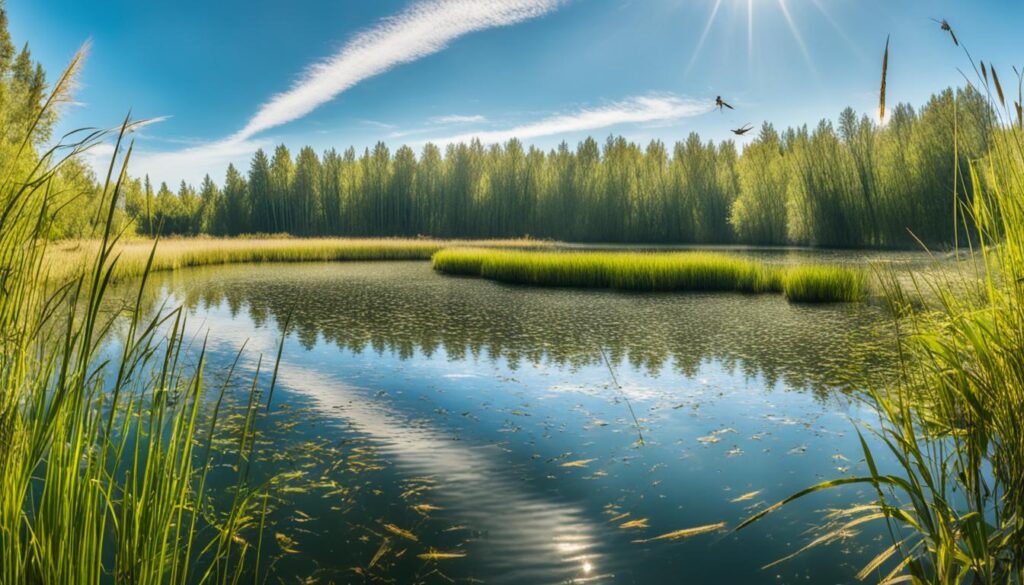Dragonflies are amazing creatures that can fly up to 100 miles in a day. They captivate us with their beautiful wings and colors. But, they also play a big role in keeping nature balanced. This guide will show you how to welcome dragonflies into your garden. You’ll learn about their life cycle, how to breed them, and what plants and water features they love.
Are you into gardening or just starting to explore it? Learning about dragonflies can make your garden more exciting. From creating spots for dragonfly young to choosing which species to attract, this guide has you covered. Your garden will soon be a lively spot for these amazing insects!
Key Takeaways
- Understanding the dragonfly life cycle is crucial for creating a suitable habitat.
- Water features and certain plants are essential to attract dragonflies.
- Creating a dragonfly nursery helps in effectively raising dragonfly larvae.
- Different dragonfly species require varied conditions and care.
- Regular care and maintenance of the habitat ensure a thriving dragonfly population.
Creating an Enchanting Dragonfly Habitat in Your Garden
Designing a dragonfly-friendly space in my garden has been a joy. It’s not just pretty – dragonflies help control pests like mosquitoes. Adding water features and the right plants makes it easy to attract and enjoy these beautiful insects.
Benefits of Attracting Dragonflies
Watching dragonflies is fun, and they eat pests like mosquitoes. Building a space for dragonflies in my garden has balanced nature. This cuts down the need for harmful pesticides, making my garden healthier.
Water Features as Focal Points
Dragonflies love water. A pond or small basins in gardens can be great for them. These areas not only help dragonflies grow but also bring peace and beauty to the garden.
Ideal Plants for Dragonfly Visitors
Choosing the right plants is key to inviting dragonflies. I’ve picked plants that support their whole life cycle. Some of my favorites include Water Lilies, Cattails, Iris, and Reeds.
| Plant Type | Benefits |
|---|---|
| Water Lilies | Provides landing pads and hiding spots for adult dragonflies and emerging nymphs. |
| Cattails | Ideal for nymphs to climb on when they are ready to molt into adulthood. |
| Iris | Attracts smaller insects, serving as a food source for dragonflies. |
| Reeds | Offers excellent vertical habitat for larvae and emerging adults. |
Creating a dragonfly habitat is thrilling and rewarding. Picking the right water features and plants boosts your garden’s look and health. It turns your garden into a haven for dragonflies and an enjoyable space for you.
Understanding the Dragonfly Life Cycle to Optimize Your Garden
Knowing the dragonfly life cycle helps you make your garden better for them. This cycle has three key stages: egg, nymph, and adult. Each stage has its own needs. Meeting these needs can boost the dragonfly numbers in your garden.
Dragonflies lay their eggs on or in water. If you want lots of dragonflies, add a small pond. This gives their eggs a safe place to grow.
Eggs turn into nymphs that live in the water. Nymphs eat many water bugs and grow by shedding their skin. This step can last a few months or a few years. A healthy water source helps these nymphs grow well.
After growing up as a nymph, it becomes an adult dragonfly. This change is very big. Adult dragonflies fly around and eat bugs. They need plants for resting and hunting their prey.
Supporting all dragonfly stages is good for your garden’s health. It also makes your garden nicer and helps with plant-harming bugs. Here’s how you can make your garden great for dragonflies:
- Create a water source: A pond or wetland feature is ideal for supporting the aquatic stages of dragonflies.
- Include plants that attract dragonflies: Choose vegetation that will serve as hiding spots for nymphs and hunting grounds for adult dragonflies.
- Avoid pesticides: Chemicals can be harmful to dragonflies at every stage of their development. Opt for natural pest control methods instead.
- Provide sunning areas: Dragonflies are cold-blooded and rely on sunlight to regulate their body temperature.
By following these tips, your garden will be a home for thriving dragonflies. This makes your garden lively and controls pest bugs.
How to Raise Dragonflies: Crafting Your Very Own Dragonfly Nursery
Starting the journey of raising dragonflies needs a dedicated dragonfly nursery. This is a key part. I’ll guide you through making a spot where dragonflies can grow from the early stages right in your backyard.
- Choosing the Right Container: Begin with a wide, shallow container that copies a natural water setting. It needs to be durable and at least 24 inches in size.
- Water and Plant Setup: Use rainwater or dechlorinated water. Include plants that offer shade and oxygen for the living creatures.
- Ongoing Care: Keep an eye on the water and keep it clean. This stops harmful algae and keeps the environment ideal for larval growth.
With this care, you can see larvae transform into adult dragonflies. Watching them grow is not only exciting but also helps your garden’s diversity.
| Material | Purpose | Frequency of Maintenance |
|---|---|---|
| Container | Habitat base | Check annually for integrity |
| Water | Medium for larvae | Refresh every two weeks |
| Aquatic Plants | Oxygen source and larval hiding spots | Prune monthly |
The Role of Water in Sustaining Dragonfly Populations

Water is vital for dragonflies, serving as more than just a home. It’s their breeding ground and place to grow. Let’s explore why water is key for keeping dragonfly numbers up.
Creating a Pond Oasis
Adding a pond to your garden helps create a dragonfly-friendly area, not just for looks. A pond provides a space for dragonflies to mate, eat, and live well. Make your pond with shallow sides and deeper parts in the middle to match their natural homes. Also, plant water-loving plants around it. This adds beauty and gives dragonflies places to rest and hide.
Water Quality and Maintenance for Dragonfly Nymphs
Keeping the water quality for dragonflies high in your pond is crucial for the nymphs, which stay underwater for a big part of their life. The water should be clean and full of oxygen for their growth. Don’t use any harmful chemicals or pollutants close to the pond. Try using a filter to keep the water clean. By doing this, you help not just the nymphs but also the adult dragonflies, keeping the whole environment balanced.
Focusing on these points helps save these amazing insects. Plus, you get the bonus of having natural bug zappers, as dragonflies eat mosquitoes and flies. Making a good water and pond oasis home for dragonflies makes your garden more in harmony and beautiful.
Incorporating Native Flora: Plants That Attract Dragonflies
Gardening for me means creating a special place for both myself and wildlife. Planting native plants helps attract dragonflies. These plants offer perfect spots for them to perch and reproduce. They also add to a garden’s health and variety in an eco-friendly way.
Emergent and Floating Vegetation
Adding emergent plants is key to welcoming dragonflies. These plants grow through the water’s surface, giving dragonflies places to lay their eggs. They also help create a home for dragonfly young, living in the water below.
- Bulrushes
- Cattails
- Water lilies
Shoreline Plant Choices
Choosing the right plants at the water’s edge is also important. Native shoreline plants not only enhance the ecosystem but help control mosquitoes. This benefits not just our enjoyment but our health as well.
- Swamp milkweed
- Joe-Pye Weed
- Ribbon grass
| Plant Type | Benefits | Height |
|---|---|---|
| Bulrush | Egg-laying site for dragonflies | 2-6 ft |
| Water lilies | Provides shade and habitat for aquatic species, attracts dragonflies | Surface level |
| Joe-Pye Weed | Attracts butterflies and dragonflies, ideal for shoreline stabilization | 6 ft |
Expert Tips for Designing the Perfect Dragonfly Sanctuary
Creating a dragonfly sanctuary in your yard brings many benefits. With the right design, you can help the local environment thrive. I’m sharing my tips on how to design a top-notch dragonfly habitat. This advice will help you succeed in your project.
Location is key. Choose a sunny spot that’s shielded from strong winds. This creates the perfect home for dragonflies. Also, you must have water. Dragonflies need it for breeding and hunting. So, adding a pond or a small fountain is a must.
Let’s go over my practical checklist. It’s all about mixing natural and artificial items to help dragonflies flourish:
- Natural vegetation: Add water lilies and cattails. They provide spaces for breeding and resting.
- Shelter: Use tall grasses and shrubs to give dragonflies a safe place from danger and bad weather.
- Artificial structures: Place perches near water, like bamboo or reeds. It helps dragonflies rest and find food.
It’s crucial to keep the ecosystem balanced. I’ve compared different design elements and their effect on dragonfly life. Here’s a snapshot:
| Design Element | Impact on Dragonfly Activity | Notes on Habitat Health |
|---|---|---|
| Shallow Water Areas | High | Improves nymph survival rates |
| Dense Vegetation | Moderate | Offers protection, but can hinder adult dragonfly movement |
| Open Water Surfaces | Low | Attracts predators, increasing risk for nymphs |
By focusing on these essential design elements, you can make a perfect spot for dragonflies. Use these expert tips to design a welcoming habitat. You’ll give dragonflies a shelter while enhancing your local environment’s diversity.
Leveraging Dragonfly Larvae for Natural Pest Control
Dragonfly larvae play a huge part in keeping pests under control naturally. These young dragonflies are expert hunters. They eat up pests such as mosquitoes in gardens and water areas.
Nymph Predatory Behavior
Dragonfly nymphs are great at hunting down insects in the water. If you make your garden friendly to them, they’ll do a better job keeping pests away. This helps you manage your garden ecosystem without using chemicals.
Mosquito Management With Dragonfly Allies
Helping dragonflies as they grow is key in the fight against mosquitoes. By letting them eat the mosquito larvae, you’re using a natural method. This way, you need less bug spray or other chemicals in your garden.
| Pest Type | Control Strategy | Effectiveness |
|---|---|---|
| Mosquito Larvae | Dragonfly Nymph Predation | High |
| Other Aquatic Pests | Natural Habitat Encouragement | Moderate to High |
Dragonflies: The Natural Jewel of Biodiversity

I’ve learned that dragonflies do more for us than just look pretty in our gardens. They are key to the world’s health and make our planet diverse. By studying dragonfly species, we learn how important they are to our planet’s balance. This knowledge makes us value the rich variety of life around us.
Identifying Local Dragonfly Species
Figuring out which dragonflies live near you is fun and interesting. Each kind is different in color, size, and where they like to live. This shows how varied and adaptable dragonflies are. Knowing about them also helps us see their role in keeping our local area’s nature in check.
Contributions to the Ecosystem
Dragonflies are important because they eat pests and are also food for other animals. This helps keep the balance in nature. They are a sign that the environment they’re in is healthy. Watching them can tell us a lot about how well our ecosystem is doing.
| Aspect | Description | Impact on Biodiversity |
|---|---|---|
| Predation | Dragonflies consume large quantities of pests. | Helps maintain balanced insect populations. |
| Indicator Species | Presence indicates clean and healthy aquatic environments. | Signifies robust aquatic biodiversity. |
| Life Cycle | Complex life cycle involving aquatic and terrestrial phases. | Supports a wide range of ecological niches. |
Learning about and protecting dragonflies helps our environment. They are living gems that brighten and heal our planet. Spotting one is like seeing nature’s beautiful, balanced dance. It reminds us to care for and enjoy the wonders of Earth’s life.
Maintaining Your Dragonfly Haven Through the Seasons
Being a good guardian of dragonflies means adjusting to each season. It’s crucial to change our methods and keep an eye on these beings. This way, we can help dragons all year round.
Seasonal Adjustments for Dragonfly Habitats
Keeping your dragonfly place just right means knowing what they need as seasons shift. In spring and summer, it’s about making sure there are good places to breed and plenty of food. Then, in fall and winter, the focus switches to keeping their homes safe from the cold, protecting the young and the sleepy adults.
Continued Care and Observation
Taking care of your dragonfly zone is a must. This means staying on top of water quality and the plants around. If you notice the dragons acting different or spot less of them, quick checks can help solve any problems. This way, they keep your yard lively.
| Season | Key Actions | Benefits |
|---|---|---|
| Spring | Plant new aquatic vegetation, check water levels | Supports growth and breeding |
| Summer | Maintain landscape, manage pests naturally | Enhances habitat appeal, supports adult dragonflies |
| Fall | Remove decaying plants, introduce winter-hardy plants | Prepares site for overwintering, protects larvae |
| Winter | Monitor ice formation, provide oxygenation if needed | Safeguards dormant adults and larvae |
Sticking to these guideposts and watching the little flyers closely does wonders for their home. This way, not only do they make your garden look better, they also keep the balance of local nature in check.
Conclusion
Looking closely at dragonflies, we’ve learned a lot about them. We’ve talked about how to raise them and make a good place for them to live. It’s a journey that taught us about nature in a deep way.
By doing things like adding water and planting local plants, we help dragonflies thrive. This not only makes our gardens nice but also helps balance nature by controlling pests. Our guide on making a dragonfly spot is useful for anyone who wants to help the environment in their garden.
Working with dragonflies is more than making our gardens pretty. It’s a way to care for nature and teach others to do the same. By making a home for dragonflies, we join in their protection. Then, future generations can see the wonder of these creatures. Remember, with the right plants, water, and effort, anyone can make a place where dragonflies and people are happy.
FAQ
What are the benefits of attracting dragonflies to my garden?
What water features should I include in my dragonfly habitat?
Which plants are ideal for attracting dragonflies to my garden?
What is the dragonfly life cycle?
How can I create a suitable dragonfly nursery?
Why is water important for sustaining dragonfly populations?
How can I attract dragonflies with plants?
What are some expert tips for designing a dragonfly habitat?
How do dragonfly larvae help with natural pest control?
What is the role of dragonflies in maintaining biodiversity?
How do I maintain a dragonfly haven throughout the year?
References
Migratory Dragonfly Partnership
The International Odonata Research Institute







